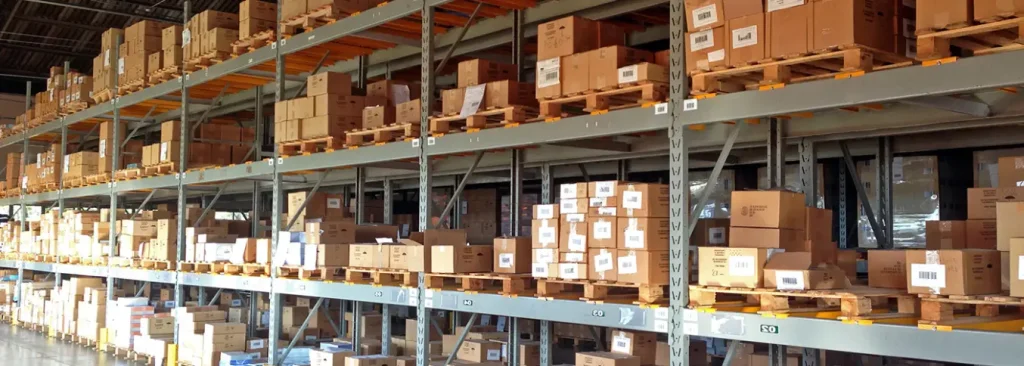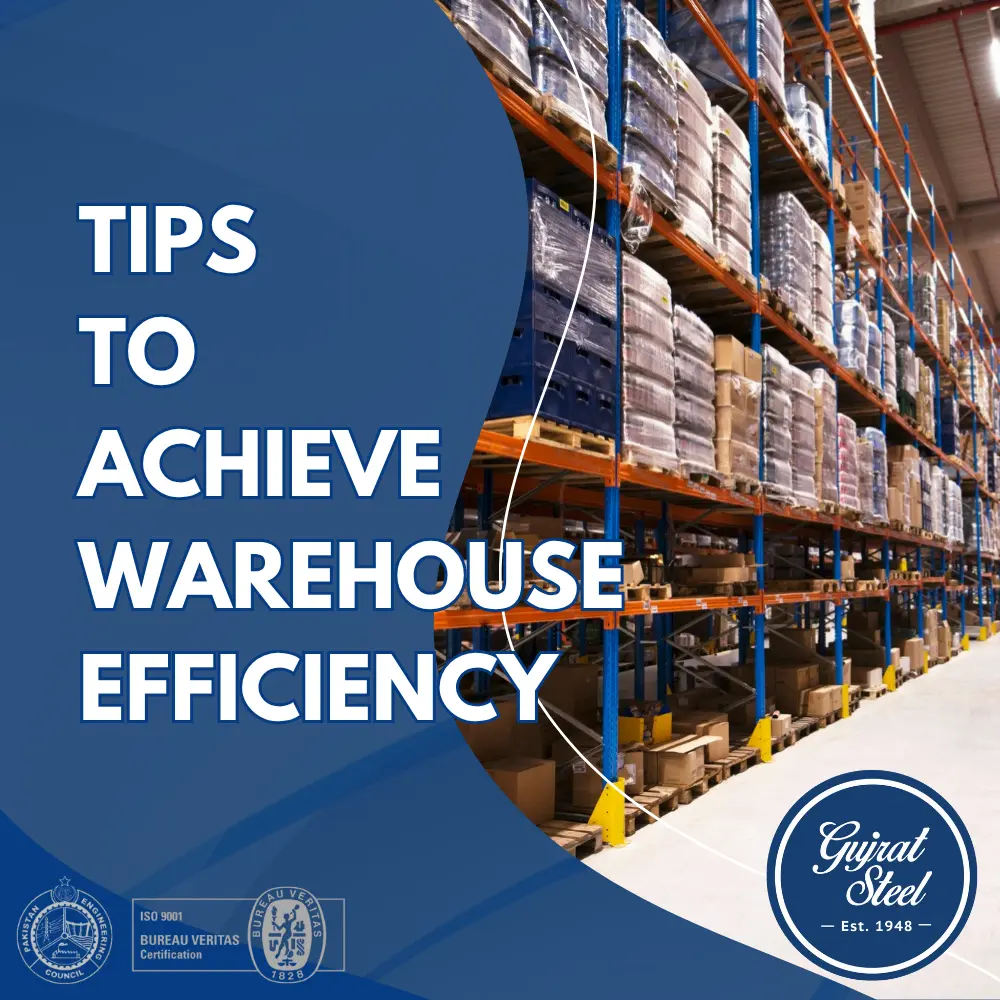Achieving warehouse efficiency is a continuous process that involves optimizing space, labor, and processes. Here are 15 detailed, actionable tips to help you achieve maximum efficiency in your warehouse operations.
Table of Contents

01. Optimize Your Warehouse Layout with ABC Analysis
- What it is: Not all inventory is equal. ABC analysis is the process of categorizing products based on their sales frequency.
- A-Items: High-demand, fast-moving products (top 20% of items generating 80% of movement).
- B-Items: Medium-demand products.
- C-Items: Low-demand, slow-moving products.
- How to achieve it:
- Place A-Items in the most accessible locations, closest to the packing and shipping stations, to minimize travel time for pickers.
- Place B-Items in the middle sections.
- Place C-Items in the back or on higher, less accessible shelves.
- Why it’s efficient: This drastically reduces the average time and distance traveled per pick, which is often the most time-consuming activity in a warehouse.
02. Maximize Vertical Space
- What it is: The floor space in a warehouse is finite, but the vertical space is often underutilized.
- How to achieve it:
- Invest in taller pallet racking and shelving systems that suit your ceiling height.
- Use the right equipment for vertical access, such as high-reach forklifts or order pickers.
- Consider installing a mezzanine level to create more floor space for offices, light storage, or assembly work.
- Why it’s efficient: It increases your storage density without the high cost of expanding the building’s footprint or moving to a larger facility.
03. Implement a Warehouse Management System (WMS)
- What it is: A WMS is software that acts as the central brain for all warehouse operations. It provides real-time visibility and control over inventory, orders, and labor.
- How to achieve it:
- Choose a WMS that integrates with your existing systems (like your e-commerce platform or ERP).
- Use it to manage inventory locations, direct picking paths, and automate order processing.
- Why it’s efficient: A WMS eliminates guesswork, reduces human error, provides valuable data for decision-making, and directs staff to the most efficient tasks.
04. Adopt Barcode and RF Scanning Technology
- What it is: Replacing manual data entry (pen and paper) with handheld scanners for all inventory movements.
- How to achieve it:
- Ensure every product and every storage location (bin, shelf, pallet) has a unique barcode.
- Equip staff with RF (Radio Frequency) scanners to log items during receiving, put-away, picking, and shipping.
- Why it’s efficient: It improves inventory accuracy to over 99%, speeds up all processes, and provides the real-time data needed for your WMS to function effectively.
05. Standardize the Receiving Process
- What it is: Creating a consistent, documented procedure for handling all incoming shipments. A bottleneck at receiving can disrupt the entire warehouse.
- How to achieve it:
- Designate a specific, uncluttered area for receiving.
- Establish a clear workflow: 1. Unload shipment -> 2. Inspect for damage and verify against the purchase order -> 3. Scan and log items into the WMS -> 4. Stage for immediate put-away.
- Why it’s efficient: A standardized process ensures inventory is accounted for accurately and put away quickly, making it available for sale faster and preventing receiving docks from becoming congested.
06. Choose the Right Picking Strategy
- What it is: Moving beyond picking one order at a time. Different strategies are more efficient for different types of operations.
- How to achieve it:
- Batch Picking: A picker gathers items for multiple orders at once in a single trip.
- Zone Picking: Each picker is assigned a specific zone in the warehouse and only picks items from that area. Orders are then consolidated at packing.
- Wave Picking: A combination of batch and zone picking scheduled in specific “waves” throughout the day.
- Why it’s efficient: These strategies drastically reduce travel time, allowing pickers to retrieve more items in less time.
07. Implement a Cycle Counting Program
- What it is: Instead of a disruptive, once-a-year physical inventory count, cycle counting involves counting small sections of the warehouse continuously throughout the year.
- How to achieve it:
- Use your WMS to schedule daily or weekly counts for specific locations or SKUs.
- Prioritize counting A-Items more frequently than C-Items.
- Why it’s efficient: It maintains high inventory accuracy year-round without shutting down operations, identifies discrepancies early, and reduces inventory write-offs.

08. Optimize Your Packing Stations
- What it is: Designing packing stations to be as ergonomic and efficient as possible, minimizing unnecessary movement.
- How to achieve it:
- Ensure all necessary supplies (various box sizes, tape, filler material, shipping label printer, scanner) are within arm’s reach.
- Use height-adjustable tables and anti-fatigue mats to reduce worker strain.
- Why it’s efficient: A well-designed station can significantly increase the number of orders a single person can pack per hour, reducing a common bottleneck.
09. Foster a Culture of Safety and Cleanliness
- What it is: Making safety and organization (like the 5S methodology: Sort, Set in Order, Shine, Standardize, Sustain) a top priority.
- How to achieve it:
- Keep aisles and walkways clear of debris and pallets.
- Provide proper training on equipment operation and ergonomic lifting.
- Ensure clear signage for aisles, locations, and hazards.
- Why it’s efficient: A safe warehouse has fewer accidents, which means less downtime, lower insurance costs, and higher employee morale and productivity. A clean warehouse is an organized warehouse, which reduces time spent searching for items.
10. Implement Cross-Docking Where Possible
- What it is: A process where incoming goods are unloaded from a truck and immediately loaded onto an outbound truck with little to no storage in between.
- How to achieve it:
- Identify high-volume, pre-sold products that are suitable for this process.
- Requires tight scheduling and coordination between inbound and outbound transportation.
- Why it’s efficient: It virtually eliminates the put-away and picking steps, saving immense amounts of time and labor for qualifying goods.
11. Invest in Employee Training and Cross-Training
- What it is: Ensuring all employees are not only experts in their primary role but are also trained to perform other warehouse functions.
- How to achieve it:
- Develop standardized training programs for all key roles (receiving, picking, packing).
- Schedule time for employees to learn other roles, such as training a picker on how to work in the receiving department.
- Why it’s efficient: Cross-training creates a flexible workforce that can be reallocated to different departments to handle bottlenecks or cover for absent employees, preventing slowdowns.
12. Use Data and Key Performance Indicators (KPIs)
- What it is: You can’t improve what you don’t measure. KPIs are specific metrics used to track warehouse performance.
- How to achieve it:
- Track essential KPIs such as:
- Order Picking Accuracy: (Total Orders – Error Orders) / Total Orders
- Inventory Turnover: Cost of Goods Sold / Average Inventory
- Receiving Cycle Time: Time taken to process an incoming shipment.
- Cost Per Order Shipped: Total Warehouse Cost / Total Orders Shipped
- Track essential KPIs such as:
- Why it’s efficient: KPIs provide objective data to identify problems, measure the impact of changes, and make informed decisions for continuous improvement.
13. Establish a Preventative Maintenance Schedule
- What it is: Proactively servicing and maintaining all warehouse equipment (forklifts, conveyors, scanners, printers) instead of waiting for it to break down.
- How to achieve it:
- Create a schedule for regular inspections, cleaning, and servicing of all critical equipment.
- Keep a log of all maintenance activities.
- Why it’s efficient: Prevents costly, unexpected equipment failures that can bring operations to a standstill. It extends the life of your assets and ensures they operate at peak performance.
14. Consider Scalable Automation
- What it is: Introducing automated systems to handle repetitive and labor-intensive tasks.
- How to achieve it:
- Low-cost: Start with automated conveyors to move goods between picking and packing.
- Mid-tier: Implement pick-to-light or voice-picking systems to guide workers.
- High-investment: Explore Automated Storage and Retrieval Systems (AS/RS) or Autonomous Mobile Robots (AMRs) for large-scale operations.
- Why it’s efficient: Automation significantly increases speed, accuracy, and throughput while reducing dependency on manual labor for strenuous tasks.
15. Get Feedback from the Floor
- What it is: Actively seeking input and suggestions from the warehouse employees who perform the tasks every day.
- How to achieve it:
- Hold regular, brief team meetings (daily huddles) to discuss challenges.
- Implement a suggestion box system (physical or digital).
- Empower employees to point out inefficiencies in their workflows.
- Why it’s efficient: Your frontline workers often have the best insights into practical problems and potential solutions. Involving them fosters a culture of ownership and continuous improvement.



